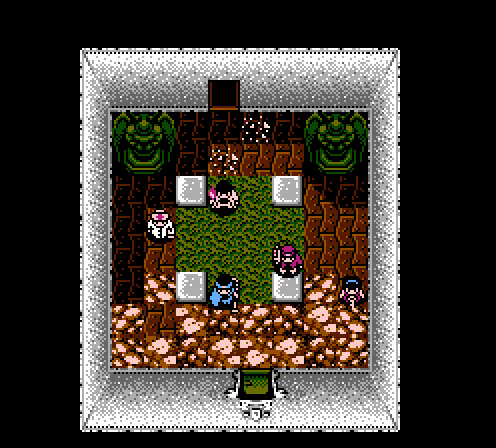Sweet Home (Fan Translation)
| |
Player's Review
Thirty years prior to the story in 1959, famous artist Ichiro Mamiya hid several precious frescos in his huge mansion before he mysteriously disappeared. In the present day, a team of five documentary film-makers seek to recover the paintings from the abandoned, dilapidated mansion.
Sweet Home is a 1989 psychological horror role-playing video game for the Nintendo Entertainment System. It is based on the Japanese horror film of the same name, and was supervised by the film's director, Kiyoshi Kurosawa. The game was developed and published by Capcom, and was released in Japan on December 15, 1989. The use of brutally horrific imagery prevented its global release. Sweet Home heavily inspired the Resident Evil series, and is considered a forerunner of the survival horror genre. Sweet Home was directed by Tokuro Fujiwara who was also the creator of Ghosts 'N Goblins and produced the Mega Man series starting with part two and later went on to create Breath of Fire.
Characters:
Kazuo - the leader of the crew of five who are creating his documentary. Has the highest HP in the game and good defense, and uses the Lighter.
Akiko - a nurse. Is the weakest character in battle, and uses the first aid Kit.
Taguchi/Taro - the cameraman. Has the highest Defense in the game and good HP, and uses the Camera.
Asuka - an art restorer and a reporter. Has low stats in battle and uses the Vacuum.
Emi - Kazuo's daughter. She is the fastest character in battle, uses the Key.
The game features randomly encountered battles which the controlled character or party of characters must fight or run away from. If a character dies in battle, he or she cannot be revived throughout the course of the game. The five characters have a specific skill that is necessary to complete the game, although items that serve the same purpose can be found if one of the characters dies. For example, should Akiko die, the team may find pill bottles which can be used to heal ailments. Depending on how many characters remain alive after the defeat of the final boss, there are a total of five different endings the player may receive.
Though it is a role-playing video game, Sweet Home served as the main inspiration for the seminal survival horror game Resident Evil, which was originally intended to be a remake of Sweet Home. Sweet Home even has a line where the mansion is referred to as "house of residing evil", and has the face-revealing turn of a Man, similar to the famous first zombie encounter cutscene in Resident Evil, and it has zombie dogs, which remind of Cerberuses from Resident Evil. The first Resident Evil borrowed many elements from Sweet Home: the mansion setting; the puzzles; the item inventory management and limited inventory; the emphasis on survival; the "door" loading screen; the use of scattered notes as storytelling mechanics; the projection room; multiple endings depending on how many characters survive; backtracking to previous locations in order to solve puzzles later on; the use of death animations; individual character items such as a lock pick or lighter; story told through frescos; and brutally horrific imagery. Emi was the original Master of Unlocking; Sweet Home preceded Fatal Frame's exorcising spirits with a Camera Obscura and maybe even Luigi's Mansion's Poltergust 3000. The game also features an early example of quick-time events.
The game is completed with all characters surviving for the best ending. After the ending, I show the rest of the cutscenes and the game over screen.
The game was never released outside Japan and never rereleased (just like the movie) because of its dark story and graphic, disturbing scenes. A fan translation was made in a joint effort by Gaijin Productions and Suicidal Translations. While it's good overall, there are a few significant flaws I need to point out: Taguchi is named "Taro" in the translation because names in Sweet Home have a five character limit; the "Tool" item is the Amulet; the words "F-Lite... Jinbi..." uttered by one of the eternally dying victims near the lake is actually supposed to be a hint about the blue Pipe being a good weapon against the walking dead.
Sweet Home is a 1989 psychological horror role-playing video game for the Nintendo Entertainment System. It is based on the Japanese horror film of the same name, and was supervised by the film's director, Kiyoshi Kurosawa. The game was developed and published by Capcom, and was released in Japan on December 15, 1989. The use of brutally horrific imagery prevented its global release. Sweet Home heavily inspired the Resident Evil series, and is considered a forerunner of the survival horror genre. Sweet Home was directed by Tokuro Fujiwara who was also the creator of Ghosts 'N Goblins and produced the Mega Man series starting with part two and later went on to create Breath of Fire.
Characters:
Kazuo - the leader of the crew of five who are creating his documentary. Has the highest HP in the game and good defense, and uses the Lighter.
Akiko - a nurse. Is the weakest character in battle, and uses the first aid Kit.
Taguchi/Taro - the cameraman. Has the highest Defense in the game and good HP, and uses the Camera.
Asuka - an art restorer and a reporter. Has low stats in battle and uses the Vacuum.
Emi - Kazuo's daughter. She is the fastest character in battle, uses the Key.
The game features randomly encountered battles which the controlled character or party of characters must fight or run away from. If a character dies in battle, he or she cannot be revived throughout the course of the game. The five characters have a specific skill that is necessary to complete the game, although items that serve the same purpose can be found if one of the characters dies. For example, should Akiko die, the team may find pill bottles which can be used to heal ailments. Depending on how many characters remain alive after the defeat of the final boss, there are a total of five different endings the player may receive.
Though it is a role-playing video game, Sweet Home served as the main inspiration for the seminal survival horror game Resident Evil, which was originally intended to be a remake of Sweet Home. Sweet Home even has a line where the mansion is referred to as "house of residing evil", and has the face-revealing turn of a Man, similar to the famous first zombie encounter cutscene in Resident Evil, and it has zombie dogs, which remind of Cerberuses from Resident Evil. The first Resident Evil borrowed many elements from Sweet Home: the mansion setting; the puzzles; the item inventory management and limited inventory; the emphasis on survival; the "door" loading screen; the use of scattered notes as storytelling mechanics; the projection room; multiple endings depending on how many characters survive; backtracking to previous locations in order to solve puzzles later on; the use of death animations; individual character items such as a lock pick or lighter; story told through frescos; and brutally horrific imagery. Emi was the original Master of Unlocking; Sweet Home preceded Fatal Frame's exorcising spirits with a Camera Obscura and maybe even Luigi's Mansion's Poltergust 3000. The game also features an early example of quick-time events.
The game is completed with all characters surviving for the best ending. After the ending, I show the rest of the cutscenes and the game over screen.
The game was never released outside Japan and never rereleased (just like the movie) because of its dark story and graphic, disturbing scenes. A fan translation was made in a joint effort by Gaijin Productions and Suicidal Translations. While it's good overall, there are a few significant flaws I need to point out: Taguchi is named "Taro" in the translation because names in Sweet Home have a five character limit; the "Tool" item is the Amulet; the words "F-Lite... Jinbi..." uttered by one of the eternally dying victims near the lake is actually supposed to be a hint about the blue Pipe being a good weapon against the walking dead.






